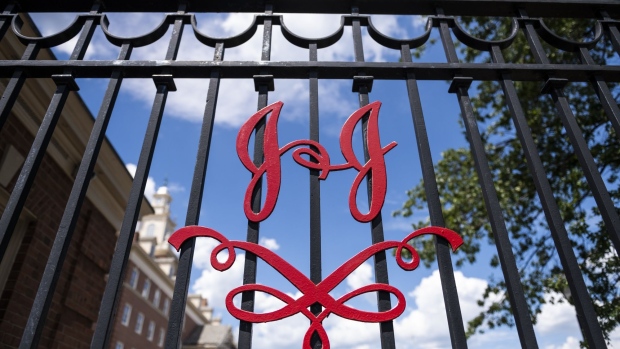Jul 21, 2021
J&J Raises Annual Forecast as Quarter Beats Expectations
, Bloomberg News

(Bloomberg) -- Johnson & Johnson raised its annual adjusted earnings and revenue forecast as quarterly sales rebounded strongly from a year ago, when the pandemic stifled non-Covid procedures.
The health-care giant boosted its profit forecast to $9.60 to $9.70 a share, up from as much as $9.57, helped by the performance of its drug and medical-device units and sales of Covid-19 shots. The company also raised its revenue outlook to as much as $94.6 billion from an earlier range that topped out at $91.6 billion.
J&J expects its single-dose Covid vaccine, which uses a different technology from messenger RNA shots developed by Pfizer Inc. and Moderna Inc., to generate $2.5 billion in 2021. Though the shot is only drawing a fraction of sales generated by its rivals, J&J anticipates deliveries will rise later this year.
“Our production levels have rebounded significantly,” Chief Financial Officer Joseph Wolk said Wednesday in an interview. “A lot of shipments will go out in the fourth quarter.”
Shares of the New Brunwsick, New Jersey-based company were little changed at $168.03 as of 9:35 a.m. in New York. They had gained 7% this year as of Tuesday’s close.
All Cylinders Firing
Second-quarter adjusted earnings were $2.48 a share, the drugmaker said, beating analysts’ average estimate of $2.29. Revenue of $23.3 billion also beat Wall Street’s view. Across the board, J&J’s units outperformed last year’s second quarter, when countries around the world went into lockdown.
“All three segments are hitting on all cylinders,” Wolk said. “I take that as a very strong sight of the health of the company. We’re better positioned today than entering the pandemic.”
Quarterly sales in J&J’s pharma unit rose 17% year-over-year to $12.6 billion, driven by drugs for cancer and immune dysfunction. Cancer drug Darzalex came in at $1.4 billion, up 59% from a year ago, and immune therapy Stelara reported $2.3 billion, an increase of 34%.
The medical-device unit, hit hard amid the pandemic as elective procedures were canceled, climbed 63% to $7 billion -- higher than pre-pandemic sales of $6.5 billion in the second quarter of 2019. Devices for knees and hips performed particularly well, reporting 94% and 74% growth respectively compared with the year-ago quarter.
Meanwhile, J&J’s consumer business jumped 13% to $3.7 billion, as pandemic-spooked consumers focused on preparedness and infection prevention. Wound-care and skin-health products were bright spots. But investors are likely to question how a recent recall of spray sunscreens contaminated with cancer-causing benzene could put a dent in the quarter to come.
Overhang
Reporting sales for its Covid vaccine for the first time, J&J said the shot brought in $164 million in worldwide sales in the quarter, with more than two-thirds of that coming from international revenue. That’s a drop in the bucket compared with mRNA shots, which are expected to be some of the year’s best-selling pharmaceutical products.
J&J’s vaccine still must overcome some hurdles. The U.S. rollout has been thwarted by production troubles, coupled with concerns over a link to rare clotting side effects. Still, U.S. health officials say the shot’s benefits outweigh its risks.
Management may be pressed on how J&J aims to increase the vaccine’s reach outside the U.S., particularly in low- and middle-income countries where doses are still desperately needed.
J&J executives are also likely to face questions about damage claims involving baby powder, artificial hips, vaginal-mesh devices and opioid painkillers.
The company may soon put some of those liabilities behind it as J&J is expected this week to finally reach a $5 billion agreement with states to resolve its liabilities over its role in the opioid overuse epidemic. Reports have surfaced suggesting the company may place a subsidiary in bankruptcy to settle claims over its talcum-based baby powder.
(Updates shares in fifth paragraph.)
©2021 Bloomberg L.P.